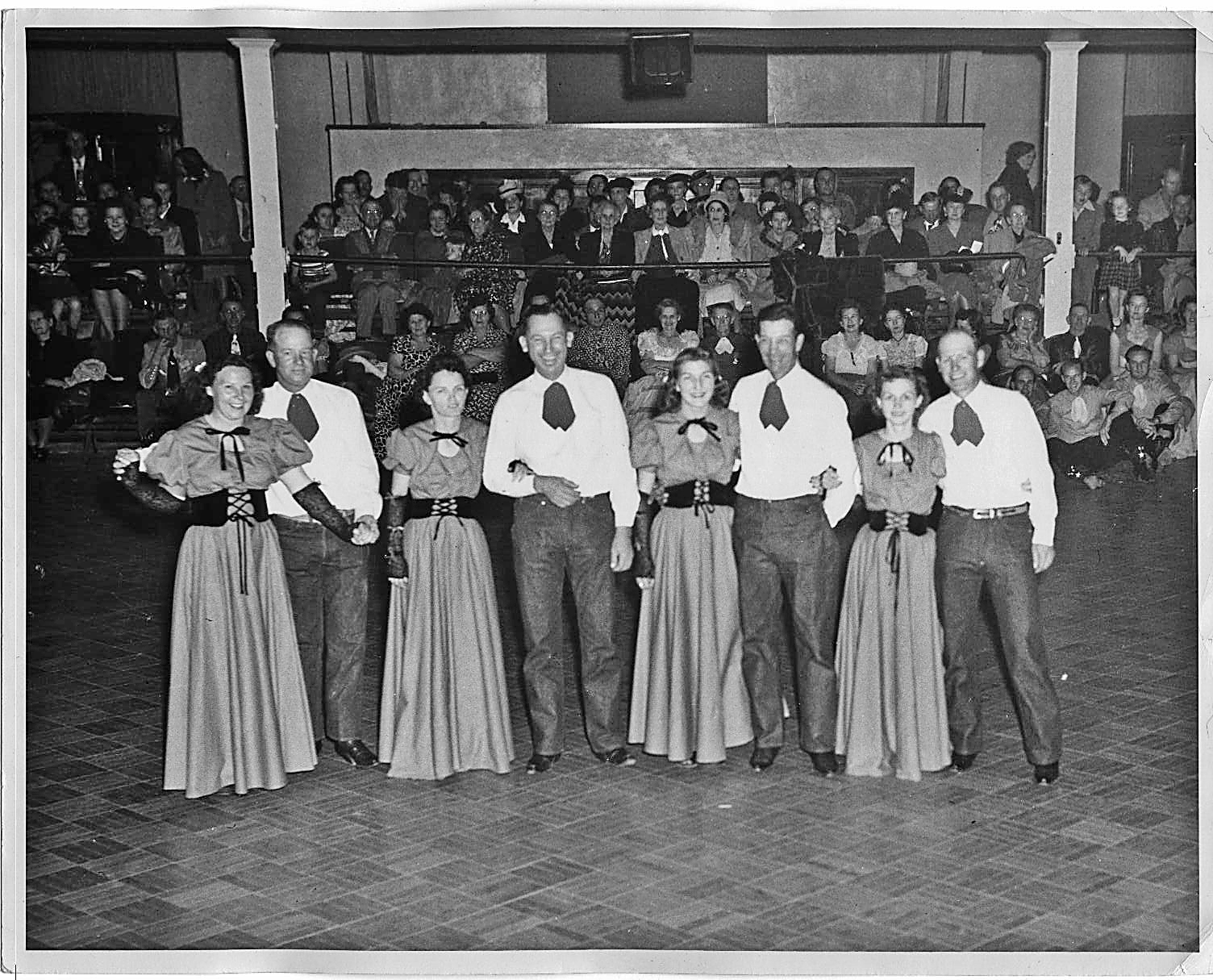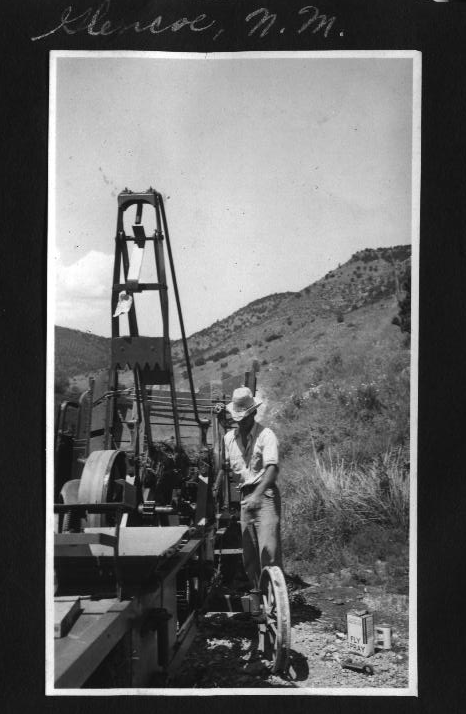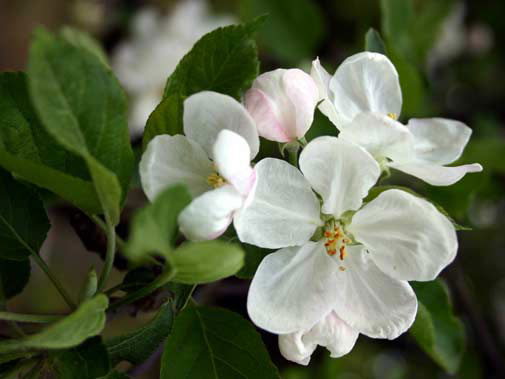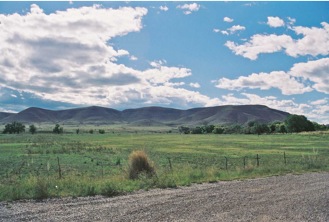







Arrival in the Hondo Valley and Making a Living (Nosker 1)
SRB: Gladys, you’re a descendent of some of the earliest settlers in Glencoe. Can you tell us when your family first came to the area and where they came from?
GN: George W. Coe came and homesteaded here in 1884. And they come from Missouri to Farmington. And it was so cold up there, and they didn’t like it, so they come down here and homesteaded.
SRB: What did they do to make a living down here?
GN: They ranched and planted orchards and agriculture.
SRB: Where was the ranch?
GN: Here in Glencoe. Just right there.
SRB: How big was it?
GN: A hundred and sixty acres is what they were allowed to homestead on. Forty-nine acres of it was under irrigation.
SRB: What kind of crops did they grow?
GN: Mostly apple orchards and all kinds of fruits. They had to raise everything they used in those days.
SRB: How many animals did they have on the ranch?
GN: Fifty. They also have a forest permit to run 50 head and they run between the farm and the forest.
SRB: In terms of the things that the farm produced, where was the market for that? You had mentioned Fort Stanton.
GN: The market was Fort Stanton in the early days, but later it was trucks come in from Texas and took the apples out . . .transport them . . . and roadside stands.
Making a Living, Social Events, and School (Nosker 3)
SRB: I’d like to hear just what it was like out here with the communal gatherings over at the Bonnell Ranch.
GN: The Bonnell Ranch was one of the three homesteads that the Coes made when they come and settled in Glencoe. And it was a . . .
LN: …dude ranch
GN: . . . convenient place for travelers to stop, so they had the gas station, dining room, and places for – cabins for travelers to stay at, ‘cause in those days it took three days to go to Roswell. And it was the largest place that we could have gatherings. And there was a dance almost every Saturday night, and they had rodeos down there, and I don’t know all the . . .
LN: They had the school.
GN: Yeah, they had the little one-room school down there.
SRB: At Bonnell’s?
GN: Across the road from the Bonnells.
LN: Right behind the church.
SRB: So that’s behind Saint Anne’s Church – the original school?
GN: Yes. And the church was there, Episcopal Church was there. And they had grades one through eight, with one teacher and in a one room school, about 20 kids, and they all walked to school every day.
SRB: Is that where you went to school?
GN: I went eight grades to Glencoe, one room school.
Social Events and Floods (Nosker 4)
SRB: Did you go to the dances and the things that were held at the Bonnell roadhouse?
GN: Always. Well, people gathered and they even come as far as Roswell to go to Bonnell dances. It was THE place to be on Saturday night.
SRB: Could you describe what went on at the dances?
GN: <laughter>
SRB: You don’t have to use any names.
GN: Well, they had music with the Coe Orchestra, they played for it. And it was a violin and Wilbur Coe played that, and his wife was Louise Coe, and she played the piano with others who filled in, and several people – different people – played guitars, and they played all old-time dances from about seven ‘till twelve. And the big dining room that they had for their dude ranch would take care of 50 people, any way. And it was most always full, and it was . . . a lot of family, you know, cause it’s three families of the Coes that live right here, adjoining ranches. And they continued meeting there from the time that I was a little girl until the flood in ’41. It washed the main building out in the flood of ’41, and so there was never any place – central meeting place – at Glencoe after Bonnell Ranch no longer was available.
RW: How did that affect the community. I mean, . . . you have that central gathering going on, and afterwards you didn’t. Did that change the community to you?
GN: Definitely. Definitely.
RW: How so?
GN: Well you just had no central place to gather all the community and surrounding families. There was no place large enough to continue. People went more to individual family gatherings at somebody’s house instead of going to Bonnell’s for a picnic, a rodeo or dance.
RW Did that mean that people lost touch with each other, because they were separated?
GN: Definitely.
Growing up (Nosker 5)
SRB: What about your life, growing up here in the valley. What was it like growing up here and going to school here? What was your daily routine like?
GN: All the family had to help with whatever job there was to do that day, because you didn’t hire any outside help, and when Sunday come, my Grandmother Coe was definitely very religious, and we took Sunday off. And most of our things were connected with school and church. We had lots of activities. Later they had the symposium, where they built the big building that’s there at the Post Office, and they held lots of different things in that. That took the place of the Bonnell community thing, because they’ve had lots of entertainment type.
Roads and Making a Living (Nosker 6)
SRB: When the highway was moved up to its current location, how did that affect the businesses, like the Perry Fruit Stand?
GN: Killed them! There was no longer traffic, and all the local people had their own fruit, and so therefore, other than if you were lucky enough to be on the new highway, you could put up a fruit stand. And only the bigger fruit stands went ahead and Coe Ranch had one of the best ones, but they remained on the new highway. Ours was off the highway, and it killed it.
SRB: In response to that [change in highway alignment], how did you market your fruit and your produce?
GN: You quit raising apples and started raising cows.
SRB: Oh.
GN: It completely changed.
GN: Well, people no longer bought apples by the box. They buy them by the pound, where they used to – a truck would come in, and they’d take the fruit to Texas, and those people had to can fruit. And time’s changed. And there’s just no longer the market for fruit. People expect to go to the grocery store and pick up three perfect apples. We didn’t raise perfect apples. You had every size apple on the tree and you had to get rid of all of them in one manner or another. We ground cider, and we packed the best ones, and sold the other ones.
Making a Living (Nosker 7)
SRB: Okay, let’s talk a little bit about the Perry Family. Your father was a driller?
GN: My father had always drilled wells from early times, but he come in and he began drilling the first irrigation wells in the valley. And later they had seven rigs that drilled all over southern New Mexico and Arizona. Their main office was Flagstaff, Arizona.
SRB: How long did the Perrys have that business?
GN: Oh, well, Dad started out drilling wells from 1910 and the boys were still drilling wells up till 2000.
GN: And at that time, why, the company, Perry Brothers, dissolved and some of the boys still drilled wells, but as individuals, after Perry Brothers dissolved. No one’s in drilling now.
SRB: In the early days did they drill a lot of wells in the valley here?
GN: Yes.
RW: Previously they had acequias everyplace, for irrigation and household.
GN: Yes.
RW: Why did they switch to wells?
GN: The wells that were drilled were only for supplemental water. And our acequias are free water. We just have to have supplemental water to be able to raise a crop.
Floods (Nosker 8)
SRB: If you could tell us a little bit about the flood in 1941 . . . the impact that it had here. Because you said it washed out the Bonnells.
GN: It started raining on the first of September and rained every day until the end of September, and then it come a hard rain at the top of the mountain, here to Roswell.
GN: A lot of cabins were lost in Ruidoso, and the water most places it was from bank to bank clear down the valley. And our house was very near the river and we – my husband was running the school bus, and he could see that – it was eleven o’clock at night and he could see that the water was coming up, and we got in the school bus and drove to the hill here at Tully’s, and later we come back and there was nothing left. And it went all the way to the Pecos River – the flood did -- and flooded the town of Roswell as well as here. And it took a lot of the county and state’s help to put the valley back into operation. The roads were washed out, and the bridge at Tinnie went out. One man who had a theater in Ruidoso and after the theater closed he was driving to Roswell, which was his home, and he went off in the canyon at Tinnie and drowned – three of them.
Changes in the Valley (Nosker 9)
RW: You’ve been fortunate enough to live in this valley to see it evolve from very early on through today and you’ve seen a lot of changes. If you’d like to tell us some of the changes that you’ve seen and the forces that you see that brought about those changes and how the people in Glencoe adapted to all those changes, that would be very interesting to hear.
GN: Tourist trade with the development in Ruidoso has changed the valley quite a bit. And a great many of the places have changed hands from people who have much more money than was ever in the valley before. There’s very little farming anymore, but most of it is gone to cattle and permanent pasture.
Making a Living (Nosker 10)
SRB: All we see out there [now] is pasture. It used to be orchard at one time?
GN: This, right here was, we had three thousand apple trees, on Perry ranch.
SRB: What varieties of apples were there?
GN: Red delicious, golden delicious, winesap and Jonathan. And Bonnells had pears. They were known for their pear orchard. You can raise any kind of fruit or vegetable here, almost. That’s one thing that made it so nice for the early settlers, ‘cause they had to be self-contained on their own farm.












